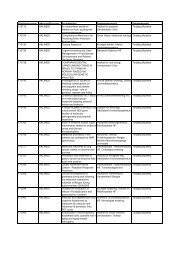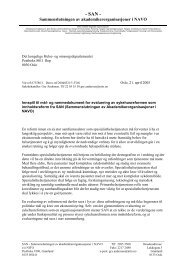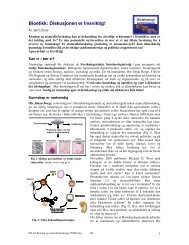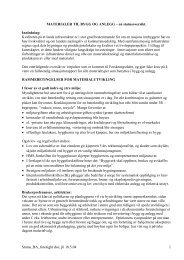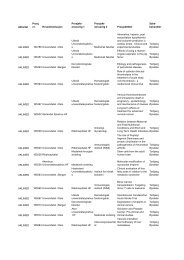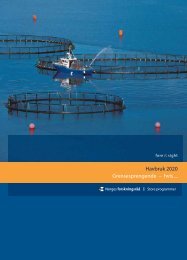A Revolution in R&D
A Revolution in R&D
A Revolution in R&D
You also want an ePaper? Increase the reach of your titles
YUMPU automatically turns print PDFs into web optimized ePapers that Google loves.
32<br />
duce targets high <strong>in</strong> quality but low <strong>in</strong> quantity, perhaps<br />
just one to five for an average disease. That<br />
would produce at best a 25–30 percent chance of<br />
yield<strong>in</strong>g a drug, given that chemistry and development<br />
rema<strong>in</strong> far from fail-safe. For disease genetics<br />
to live up to its promise, it will need to improve<br />
those odds considerably. And to do that, it will have<br />
to call on a supplementary technique: pathway<br />
analysis.<br />
Disease-susceptibility genes, if identified through<br />
disease genetics, serve not only as targets themselves,<br />
but also as guides to additional targets. The<br />
genes form part of broader disease pathways, and<br />
these pathways conta<strong>in</strong> other molecules that may<br />
serve as targets (perhaps 10 to 15 targets per pathway,<br />
accord<strong>in</strong>g to experts). These new targets are<br />
identified by pathway analysis, often tak<strong>in</strong>g the form<br />
of the study of “simple” experimental systems, such<br />
as those of Drosophila melanogaster or C. elegans (a.k.a.<br />
fruitflies and worms). When studied <strong>in</strong> the laboratory,<br />
these systems disclose the genetic components<br />
of a given pathway. (Other approaches to pathway<br />
analysis <strong>in</strong>clude expression profil<strong>in</strong>g of tissue samples<br />
and studies of prote<strong>in</strong>-prote<strong>in</strong> <strong>in</strong>teraction.)<br />
Implement<strong>in</strong>g pathway analysis will result <strong>in</strong> a lower<br />
cost per drug on average: it improves efficiency.<br />
Costs are reduced because pathway studies are relatively<br />
<strong>in</strong>expensive and fewer human-derived targets<br />
are required—pathway analysis expands the pool of<br />
potential targets tenfold or more. As targets, they<br />
prove to be of high quality, moreover (<strong>in</strong> keep<strong>in</strong>g<br />
with the disease-susceptibility gene that <strong>in</strong>spired<br />
their discovery), achiev<strong>in</strong>g good success rates <strong>in</strong><br />
cl<strong>in</strong>ical trials. For although they themselves are not<br />
yet validated <strong>in</strong> humans or clearly implicated <strong>in</strong> the<br />
disease, they participate <strong>in</strong> a pathway that is.<br />
So pathway analysis should give human studies the<br />
requisite boost, with enough targets emerg<strong>in</strong>g to<br />
yield a drug more often than not. On the down<br />
side, there are the time and cost of additional animal<br />
research and the loss of some advantages <strong>in</strong><br />
cl<strong>in</strong>ical trials. Add<strong>in</strong>g pathway analysis, via genetic<br />
studies of Drosophila melanogaster, to <strong>in</strong>direct<br />
genome-wide association studies would result <strong>in</strong> a<br />
total sav<strong>in</strong>gs of $425 million for each drug on average,<br />
regardless of the orig<strong>in</strong>al human study<br />
approach, though it would add nearly two years of<br />
additional work (produc<strong>in</strong>g an additional $255 million<br />
of value per drug).<br />
The first one to do genetic studies takes a huge risk.<br />
If it works, you’ll see everyone runn<strong>in</strong>g to jo<strong>in</strong> the<br />
crowd.<br />
—R&D executive,<br />
lead<strong>in</strong>g pharmaceutical company<br />
Implement<strong>in</strong>g Disease Genetics<br />
The sav<strong>in</strong>gs promised by disease genetics are enormous,<br />
and companies cannot ignore them. But they<br />
cannot ignore the risks either, and will need to exercise<br />
rigorous selectivity and discipl<strong>in</strong>e when it comes<br />
to pursu<strong>in</strong>g specific disease genetics studies—which<br />
approaches to adopt, for <strong>in</strong>stance, and which diseases<br />
to explore. Plac<strong>in</strong>g bets <strong>in</strong> this way is go<strong>in</strong>g to<br />
be nerve-rack<strong>in</strong>g enough. But companies face<br />
another difficult set of choices as well, <strong>in</strong> the various<br />
operational issues that need to be addressed.<br />
Plac<strong>in</strong>g Bets<br />
Some diseases have clear appeal as objects of<br />
genetic research: asthma, Alzheimer’s disease, and<br />
diabetes, for example, be<strong>in</strong>g complex diseases that<br />
afflict large populations and obviously conta<strong>in</strong> heritable<br />
factors. They have already become competitive<br />
areas of study. Although op<strong>in</strong>ion is still divided<br />
over the likely impact of disease genetics, substantial<br />
bets are be<strong>in</strong>g placed by various companies—<br />
emerg<strong>in</strong>g biotechs and established pharmaceutical<br />
companies alike. A few claim they are already see<strong>in</strong>g<br />
benefits from their <strong>in</strong>vestments: follow<strong>in</strong>g its<br />
alliance with Roche, deCODE genetics claims to<br />
have succeeded <strong>in</strong> identify<strong>in</strong>g a gene contribut<strong>in</strong>g<br />
to cerebrovascular disease; GlaxoSmithKl<strong>in</strong>e has<br />
announced f<strong>in</strong>d<strong>in</strong>g genes associated with migra<strong>in</strong>e,<br />
Type II diabetes, and psoriasis; and Genset, a<br />
French biotech company, is reported to have identified<br />
genes implicated <strong>in</strong> prostate cancer and<br />
schizophrenia.<br />
But all companies embarked on, or <strong>in</strong>tent on, pursu<strong>in</strong>g<br />
disease genetics must acknowledge that it is



